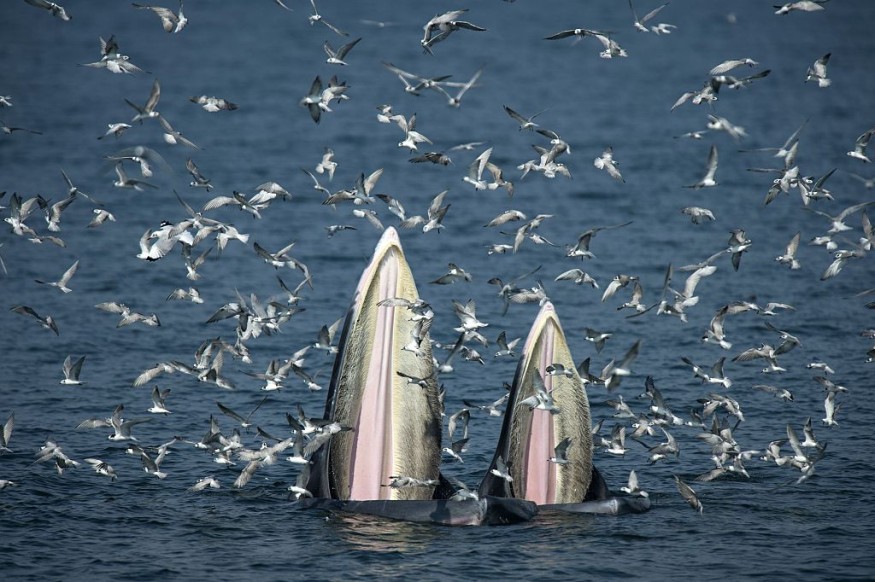Baleen whales, such as humpback whales, right whales, and blue whales, mostly feed hundreds of feet deep in the ocean, which is why their feeding habits are not easily observable. Most whale species eat voraciously for months and then fast for the rest of the year, which complicates tracking their behavior.
But there are instances when humans have filmed the way whales feed on the water surface, giving insights into how they behave underwater when eating. Like a video of a baleen whale feeding on small fishes, which went viral again on social media platforms. The viewers were amazed at how much the whales could eat.

This picture taken on November 20, 2016 shows a mother Bryde's whale (L) and her calf feeding on anchovies in the Gulf of Thailand, off the coast of Samut Sakhon province.
A Whale Trap In The Gulf Of Thailand
Last year, Bergie Gregory, a wildlife filmmaker, shared drone footage of a massive whale feeding itself with a school of fish in the Gulf of Thailand by simply opening its big mouth on the water surface. The fish swam into it without realizing that it was a trap. When the whale had enough, it abruptly closed its jaws.
According to Gregory's caption, due to the hypoxic environment and sewage outflows from the land, the whale's prey can only live in the surface layer of the water. By treading water and keeping the corners of its mouth below the surface, the whale seemingly pulls the fish into its mouth for an easy feed. The video shows how the fish jumps out of the water and right into the whale's mouth.
After a year, the video has remained viral. Many still share it on Facebook and Twitter.
Here's the original video.
How Much Do Whales Eat?
Since their feeding habits are rarely seen, scientists have to use devices to tag them and finally observe how they eat. These devices are equipped with accelerometers, GPS, magnetometers, gyroscopes, light sensors, and cameras attached at the back of the whales. In a way, it is like creating a whale version of an iPhone that scientists can track.
National Geographic reported that scientists previously analyzed the metabolic needs of whales based on their size to estimate how much baleen whales eat. For instance, they would measure how much orcas or killer whales eat by extrapolating what humpback whales or blue whales eat. However, this is not a very good way to accurately know how much whales eat.
So, a team of scientists led by Stanford University's Hopkins Marine Station postdoctoral fellow Matthew Savoca tagged 321 whales from seven baleen species. The team noted that just like the phones, the tags allowed them to track the movements of whales and detect how often they catch food.
Using drones like the one that captured the viral video of a whale feeding, they were able to measure the size of the whale's mouth and calculate the volume of water it captures as it lunges on the school of fish. More so, they used sonar to measure the density of krill living in the habitat to determine how many of them could the whale swallow with each lunge.
They found that baleen whales lunge or accelerate through the water in quick bursts while their mouths are open. They also discovered that the tagged animals ate 5% to 30% of their body weight in krill each day, like blue whales that consume 16 tons of plankton daily. This is contrary to the previous belief that whales only consume less than 5% of their body weight every day.
ALSO READ: Aerial Survey Revealed an Endangered Whale Giving Birth While Being Entangled in a Fishing Rope
Whale Food Preferences and Sources
According to the website of Seaworld Parks & Entertainment, most baleen whales feed intensively in high latitude, productive waters for four to six months in the summer and spend the rest of the year traveling and breeding.
Whales feed low on the food chain and primarily consume zooplankton and small fishes that they encounter in large swarms of schools. Aso, right whales feed on shrimplike crustaceans called krill and on a type of small crustaceans called copepods.
On the other hand, rorquals eat larger prey than right whales. Although some species also eat a variety of small crustaceans, squids, and schools of fish. Meanwhile, blue whales mostly eat krill like fin whales.
Humpback whales, minke whales, ad Bryde's whales mostly eat krill and small schools of fish. Generally, the food preferences of whales could vary in species and in the location they are in, whether in the northern or southern hemispheres.
Check out more news and information on Whales in Science Times.
© 2026 ScienceTimes.com All rights reserved. Do not reproduce without permission. The window to the world of Science Times.










